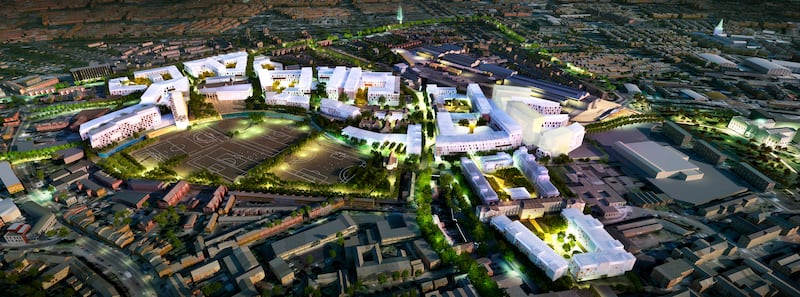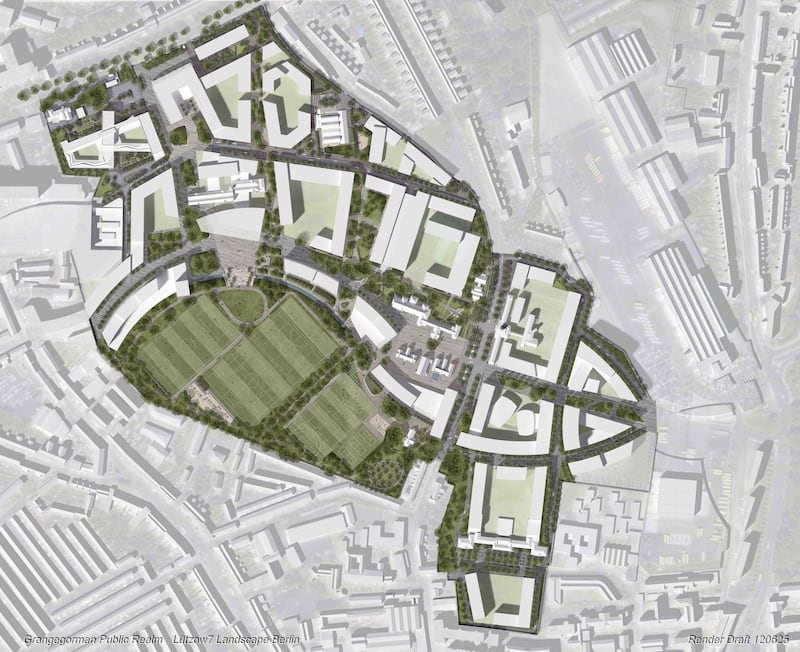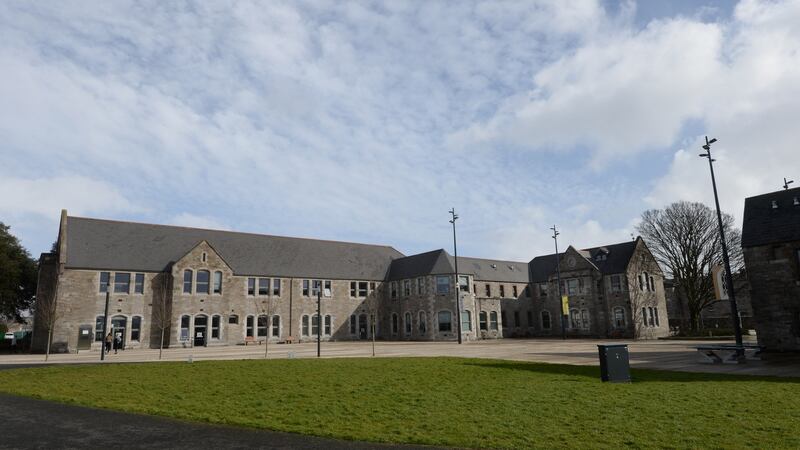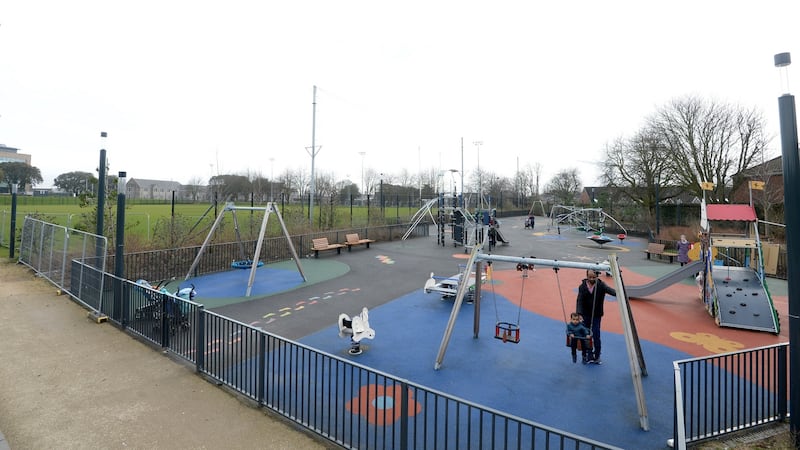For two centuries or so, Grangegorman was a place to avoid. Few ventured behind the high walls of the old asylum on Dublin's northside which, at its peak, housed up to 2,000 patients. This largely hidden side of Ireland seemed to function as a closed, confined space, cut off from the rest of society.
Today, this vast walled-in and unknown part of the city is being opened up. A new urban quarter is slowly taking shape – as host to the biggest higher-education project in the history of the State. Over the coming years, some 20,000 students will be based at Dublin Institute of Technology’s sprawling new campus.
Pedestrian walkways and the cross-city Luas are already reconnecting the 73-acre site back to the wider city. Playing fields, a playground, a primary-care centre and new primary school on campus are being used by the surrounding community.
Soon, construction will begin on the first of several large-scale jigsaw pieces: faculty buildings for DIT, a theatre, gyms and apartments.
The multiplier effect of all this social and economic development will be considerable. Its potential impact, say some, could rival the kind of large-scale urban renewal last seen in Georgian-era Dublin.
In common with the Wide Street Commission of the time, the new project is being delivered through a combination of State funding, philanthropy and public-private partnerships.
‘Parties, noise’
But there are real concerns. The sheer scale of the development will change the character of the area forever. Some in this long-established community say they are only now waking up to the scale of the development.
Apartment blocks for about 5,000 students are planned or under way in the north inner city; more than half of those within 500 metres of the campus.
At a recently constructed gated student accommodation scheme – kitted out with flat-screen TVs, en suite bathrooms and access to communal cinemas and gyms – prices start at more than €1,000 a month, well out of reach for your average student.
Some locals fear the area will become overwhelmed by students, who would account for 60 per cent of the population in the Grangegorman area if all proposed schemes get the go-ahead.
“This is a nice, safe, lovely place to live,” says the resident of a terraced home, who declines to be named. “But an influx of students inevitably changes any residential area.
"I'm fearful of what will happen: parties, anti-social behaviour, noise at night time . . . you hear similar concerns in places like Belfast and Cork. There's no reason to believe this will be any different."


Another resident says investors are already snapping up local houses to rent and feels the voices of local people have been ignored by planning authorities.
“The planning process is a waste of time. It’s a big, State-based machine we’re up against,” says one local, whose home backs onto the next phase of the development. “We’re going to be living in the middle of a construction site for the next 10 or 20 years. There are already parking problems and congestion. All of that will just get worse.”
Grangegorman is what’s known as a “strategic development zone”, or SDZ, which allows for fast-track planning permission and limits the scope to appeal decisions.
Some small business owners also have mixed views. While most see the benefits of a much bigger population on their doorstep, some fear being elbowed aside by developers keen to maximise their profits.
Graham Kelsh runs a deli and newsagent in the Park Shopping Centre, off Prussia Street. The building's owners want to demolish the centre, which includes a Tesco supermarket, to make way for a seven-storey development, which would include apartments for more than 500 students.
“For us, nothing has changed yet. There aren’t many students there – but it’s a worry. I’m five years into a 25-year lease. There’s an older population here, there are worries about anti-social behaviour. It could also be good; the area is run-down and will benefit, but there are worries.”

Ger Casey, chief executive of the Grangegorman Development Agency – the State-backed agency overseeing the development – acknowledges the concerns. "They are views that are totally understandable. Without having studied this in detail, I might have held similar views myself," he says.
He says studies show on-campus, or adjacent accommodation, is good for the city in that it relieves pressure on transport. It also frees up accommodation in the area for families or workers.
Apartments for about 2,000 students will be accommodated on the site itself. Demand is so high he believes other student accommodation planned by private developers on the perimeter of the site is a good thing. Well-managed and controlled student accommodation, he says, is not associated with problems around anti-social behaviour.
“That’s the feedback from studies on this. We feel confident the developers we’re in touch with are involved in good-quality and well-managed developments,” he says.
‘It would be great to go there’
Whatever about the changes to come, the profile of Grangegorman and the surrounding neighbourhoods has shifted significantly.
Rising numbers of young professionals have moved to places such as Stoneybatter in recent years, sparking a boom in trendy pubs and restaurants.
There’s also been an influx of nationalities and ethnic groups; the latest census shows about one in three residents is a non-Irish national.
These changes tend to mask the fact that there are pockets of real poverty and deprivation.The proportion of unemployed people and single-parent families is, for example, about twice the national average.
Patrick McCormack is principal of “The Brunner”, or St Paul’s CBS, on nearby Brunswick Street. On the wall of his office is a motto: “Strength and courage aren’t always measured in medals and victories. They are measured in the struggles they overcome.”
About a third of his students progress to third level, which is about half the national average. In affluent areas, about three times as many go on to higher education.
“Now that there’s a university on our doorstep, we hope it will break down those walls that are preventing students in disadvantaged areas going on to study at third level,” says McCormack. “They’ve been very responsive; I get the strong impression that they’re serious about linking in with all the schools.”

The school uses DIT’s all-weather soccer, tennis and basketball pitches at preferential rates; it is also involved in academic link-ups.
Denis Popa, a 16-year-old sixth-year student, has spent time on the campus and is thinking of applying for a course there. "It's right beside us; it would be great to go there. It feels open, it's a nice, calm atmosphere. I'd like to do something in science," he says.
Craig Fitzharris, a Junior Cert student, says he's been up on campus regularly for science and programming projects. "You get to know what they do and you get to know people involved. It's also a nice place to hang out."
While many local residents have concerns over student accommodation,others see the opening up of the campus as a very positive development. They can walk their dogs, bring children to the playground.
A serpentine walkway weaves its way through the campus from Stoneybatter in the west to King’s Inns in the east; a route that was never possible before. Soon, work will get under way on a plaza near Broadstone, which will be the main entrance on the city side.
For community workers, the fact that amenities for the local area were fast-tracked speaks volumes. "What really impressed me was that the first thing that was built, before anything else, was a playground," says Owen Binchy of An Síol, a community development project that serves the needs of more vulnerable members of the northwest inner city.
“It instantly brought young parents into the grounds of the colleges. That, for me, as a statement, was phenomenal. It leaves you optimistic that this will have a really good dynamic in the local community.”
Part of the city
Architect Ger Casey says meeting the needs of the community is a central part of their plans. “We’re not just here to build large buildings. We’re encouraged [by] how well it has worked out so far. The community feels a sense of ownership of the site.”
A local employment clause means that up to 20 per cent of labour will be locally sourced. “The challenge is how to develop a piece of the city that is student-oriented and welcomed by the local community, and structured so it’s part of the fabric of the city,” he says.
In a sense, the development is in its infancy. Casey estimates that less than 10 per cent has been completed so far. A number of major projects are planned that will bring 10,000 students to the site by 2020, he says, but the full development may not be completed until 2030.
Growing up on Dublin's northside, Casey recalls the scary connotations around Grangegorman. Kids, he says, would taunt each other that they'd end up there. Even as student at Bolton Street years later, it was a few years before he realised what was behind the high walls.
“It’s lovely to be involved in something that will change the connotation of Grangegorman from being something that many were fearful of to being a positive development.”









